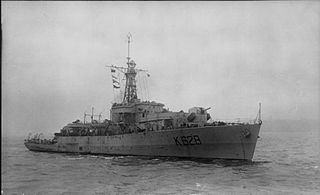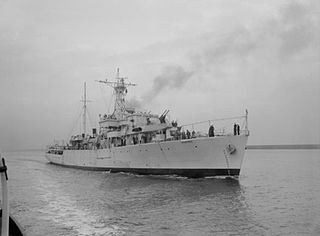
HMS Loch Alvie was a Loch-class frigate of the Royal Navy, named after Loch Alvie in Scotland. She was ordered by the Royal Navy during World War II, but did not see action with them, having transferred to the Royal Canadian Navy before commissioning. After the war she returned to the Royal Navy and would pass in and out of service until 1963.

HMS Loch Fada was the lead ship of the Loch-class frigates of the British Royal Navy, built by John Brown & Company of Clydebank, Scotland, and named after Loch Fada in the Inner Hebrides.

HMS Loch Insh was a Loch-class frigate of the Royal Navy, named after Loch Insh in Scotland. She was built by Henry Robb of Leith and launched on 10 May 1944. After service at the end of World War II she was decommissioned, but reactivated in 1950 and served, mostly in the Persian Gulf, until 1962. The ship was sold to the Royal Malaysian Navy in 1963 and renamed KD Hang Tuah (F433). She was scrapped in 1977.

HMS Loch Killisport (K628/F628) was a Loch-class frigate of the British Royal Navy, named after Loch Killisport in Scotland. Launched in 1944, the ship was not commissioned until July 1945, and served in post-war repatriation operations in the Far East until decommissioned in April 1946. During this time Prince Philip was an officer on board this ship. Recommissioned in 1950 she served in the Home Fleet for two years, before being extensively modernised for service in the Persian Gulf and Far East. Decommissioned in August 1965, she was sold for scrapping in 1970.

HMS Morecambe Bay was a Bay-class anti-aircraft frigate of the British Royal Navy, named after Morecambe Bay on the north western coast of England. In commission from 1949 until 1956, she saw active service in the Korean War, and was sold to Portugal in 1961 to serve as NRP Dom Francisco de Almeida until 1970.

HMS Cardigan Bay was a Bay-class anti-aircraft frigate of the British Royal Navy, named after Cardigan Bay, off the coast of Ceredigion, Wales.
HMS Largo Bay was a Bay-class anti-aircraft frigate of the British Royal Navy, named for Largo Bay in Fife.
HMS St Brides Bay was a Bay-class anti-aircraft frigate of the British Royal Navy, named for St Brides Bay in Pembrokeshire. In commission from 1945 to 1961, she served in the Mediterranean and Eastern Fleets, seeing active service in the Korean War.
HMS Start Bay (K604/F604) was a Bay-class anti-aircraft frigate of the British Royal Navy, named for Start Bay in Devon. In commission from 1945 to 1946 in the Mediterranean Fleet, she spent most of her career in the Reserve Fleet.
HMS Tremadoc Bay was a Bay-class anti-aircraft frigate of the British Royal Navy, named for Tremadoc Bay in north Wales.

HMS Veryan Bay was a Bay-class anti-aircraft frigate of the British Royal Navy, named after Veryan Bay on the south coast of Cornwall. In commission from 1945 until 1957, she saw service in the Pacific, Mediterranean, and Home Fleets, in the West Indies and in the South Atlantic.

HMS Whitesand Bay was a Bay-class anti-aircraft frigate of the British Royal Navy, named for Whitesand Bay in Cornwall. In commission from 1945 to 1954, she served in the Pacific, Mediterranean, West Indies and Far East Fleets, seeing active service in the Korean War.

HMS Widemouth Bay was a Bay-class anti-aircraft frigate of the Royal Navy, named for Widemouth Bay in Cornwall.

HMS Surprise was a Bay-class anti-aircraft frigate of the British Royal Navy. In commission from 1946 to 1965, she served in the Mediterranean Fleet as a Despatch Vessel for the Commander-in-Chief. Although principally employed for the use as a yacht by the CinC, Surprise was also deployed in its operational role as an anti-aircraft frigate and was allocated to the Haifa Patrol for a brief period in 1948. The archaic term "Despatch Vessel" was replaced by "Flag Frigate" in 1961.

HMS Loch Fyne was a Loch-class frigate of the British Royal Navy, built by the Burntisland Shipbuilding Company Ltd, Burntisland, Fife, Scotland, and named after Loch Fyne in Scotland. The ship was launched in 1944, and served at the end of World War II. Recommissioned in 1951, she served in the Persian Gulf and was scrapped in 1970.

HMNZS Rotoiti (F625) was a Loch-class frigate of the Royal New Zealand Navy (RNZN), which had formerly served in the British Royal Navy as HMS Loch Katrine at the end of World War II.

HMNZS Hawea (F422), formerly HMS Loch Eck (K422), was one of six Loch-class frigates that served in both the Royal Navy (RN) and the Royal New Zealand Navy (RNZN). The ship was laid down by Smiths Dock on 25 October 1943, launched on 25 April 1944 and commissioned into the Royal Navy as HMS Loch Eck on 7 November 1944.

HMS Loch Achanalt was a Loch-class frigate of the Royal Navy that was loaned to and served with the Royal Canadian Navy during World War II. Ordered from Henry Robb, Leith, on 24 July 1942 as a River-class frigate, the order was changed, and ship laid down on 14 September 1943, and launched by Mrs. A.V. Alexander, wife of the First Lord of the Admiralty on 23 March 1944 and completed on 11 August 1944. After the war she was transferred to the Royal New Zealand Navy and renamed Pukaki.

The second HMS Essington (K353), and the first ship of the name to see service, was a British Captain-class frigate of the Royal Navy in commission during World War II. Originally constructed as a United States Navy Buckley-class destroyer escort, she served in the Royal Navy from 1943 to 1945.

HMS Dianella was a Flower-class corvette of the Royal Navy. She served during the Second World War.
















